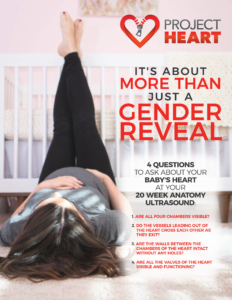Thanks to improved technology, more severe heart defects are now often identified at the 20 week anatomy ultrasound – but not always. If your baby’s hospital does not offer one after birth, request a pulse ox test to check your baby’s oxygen level. This simple and painless test is an easy way to screen for more severe defects that may otherwise go unnoticed until life-threatening symptoms arise.
Some babies may not be diagnosed until they begin to show symptoms days, weeks, or months after birth. What symptoms may indicate an undiagnosed congenital heart defect?
If your baby is experiencing any of these symptoms seek medical attention immediately.
Minor defects are most often discovered at routine well-check appointments. Your pediatrician may notice a murmur which could indicate the presence of a congenital heart defect.
If a heart defect is suspected an echocardiogram (ultrasound of the heart) will likely be recommended. An echocardiogram uses sound waves to create images of the hearts chambers, valves, and vessels. A cardiologist will evaluate how the blood moves through the heart and measurements can be taken of the heart’s structures.
In some cases, heart defects may go undetected until adolescence or early adulthood. These cases often require rapid intervention due to a sudden onset of symptoms.

Copyright 2023 – All Rights Reserved Project Heart | Privacy Policy